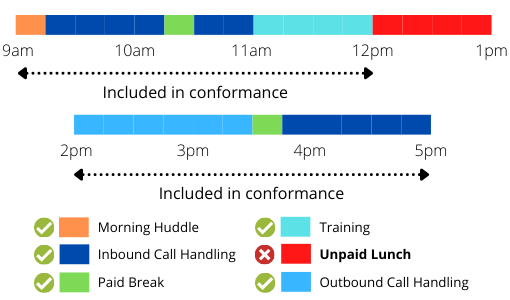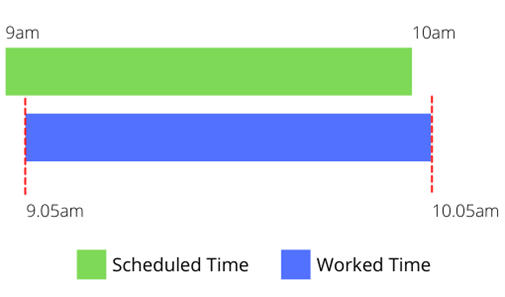Conformance is a critical yet often misunderstood metric in contact centre management. While it may sound straightforward, many contact centres confuse it with similar metrics like adherence, leading to inaccurate performance assessments.
In this article, we investigates how conformance is measured in the contact centre, giving lots of advice for managing the metric along the way.
What Is Conformance?
Contact centre conformance is a percentage measure of the time that an advisor works with respect to the time that they are being paid to work.
The word “paid” is crucial here. It means that all the time an advisor spends in training, one-to-ones and meetings contributes towards their conformance rate.
This is demonstrated in the diagram below.

Another simple way to think of conformance is as a measure of whether you are getting enough “bang for your buck”.
Yet the metric does not consider when the advisor works in comparison to their schedule. That’s adherence.
The Conformance Formula
Most contact centres will use the following formula to calculate conformance:
Conformance = (Time Worked by the Advisor ÷ Time the Advisor Was Paid to Work) x 100

To give an example of how to use this equation in practice, let’s say:
- An advisor has seven hours or 420 minutes of paid work scheduled
- Yet they only work for six and a half hours or 390 minutes
Well then, that advisor’s conformance rate will equate to 92.86%. This is because:
Conformance = (390 Minutes ÷ 420 Minutes) x 100 = 92.86%

But is 92.86% a good figure for conformance? Well, that would depend on the target that you set. In the majority of contact centres, however, 92.86% would be considered unacceptable.
After all, the advisor is effectively being paid for 30 minutes of work that they were not able to complete. If that figure were to repeat itself over a month with 24 paid days, that advisor will be paid for 12 hours of work that they have not completed.
While this is an extreme example, it highlights the value of managing conformance within the contact centre.
Conformance vs. Adherence
Conformance is often confused with adherence in the contact centre. This is a big mistake, as they are two different metrics and each has its own importance.
Also calculated as a percentage, adherence is a measure of the time that an advisor has worked with respect to the time that they are being scheduled to work.
The formula for measuring adherence is shown below:
Adherence = (Time in Adherence ÷ Scheduled Time) x 100

To further highlight the distinction, let’s take an example of an 8am–9am micro-shift in which the advisor starts five minutes late but also finishes five minutes late:

In this example, the advisor achieves 100% conformance, as the advisor has been paid to work for an hour and they have worked for an hour.
However, they work 55 of their scheduled 60 minutes, so they only achieve 91.67% adherence.
Why is this adherence figure important? Well, measuring adherence ensures that advisors are in the right place at the right time, helping the contact centre to perfectly execute its staffing plans.
Also, as Phil Anderson, Director at The Forum, says: “While conformance and adherence are two separate metrics, it is important that they are measured in tandem to gain a true, accurate representation of an individual’s productivity.”
To find our more on adherence and how it’s measured, read our article: How Do I Calculate Schedule Adherence
Should Contact Centres Set a 100% Conformance Target?
Conformance will have an impact on the bottom line of a business, as it represents a cost. More to the point, it indicates how advisor behaviour drives cost.
For this reason, many contact centre professionals believe that conformance should be a zero-tolerance policy that is monitored closely.

“Whatever you set your conformance target at, advisors should not be allowed to get simply close to that percentage and be commended for it,” says Phil.
Many would be even stricter and set 100% targets for conformance, believing that the very least an advisor can do is work the number of hours that the contact centre is paying them to.
Managing Conformance
By measuring and managing conformance, a contact centre can improve:
- Budget planning
- Resource allocation
- Operational readiness
- Operational effectiveness
Also, if advisors conform to their schedules, you’ll be more likely to meet your high-priority metrics, including customer satisfaction, productivity and sales volume.
Yet the trouble with conformance is that it is too often misunderstood at the advisor level.

“Be human in how you broach the topic of conformance, as it can be easy to come across as ‘controlling’. The key is for the metric to be coached to advisors in the context of ‘the bigger picture’,” says Justin Robbins.
So, paint a picture in induction training of why conformance is important for advisors, their colleagues, customers and the business as a whole.
Then, when the team understands the purpose of conformance, specify what is expected of them, the good behaviours that you’re looking to drive and how the metric is measured.
Placing conformance statistics on the advisor desktop is a very good follow-up to encourage advisors to self-manage their performance.
Who Else Needs to Know About Conformance?
It’s not just advisors who should understand, acknowledge and manage conformance, each of the following groups should too:
- Team Leaders – To manage and lead people in the right way.
- Operational Managers – To correctly guide team leaders.
- HR – To monitor behaviours and pinpoint motivations.
- Finance – To set accurate budgets.
Don’t overlook finance. This is really important. They need to know that conformance exists, what the metric indicates and the impact that it has on contact centre productivity.
If finance does not factor in conformance, your budget will suffer and that will adversely impact contact centre performance.
More Classic Conformance Mishaps
Confusing conformance with adherence is not the only mistake that contact centres often make when measuring and managing conformance.
Others Include:
- Excluding scheduled offline activities – Do not omit scheduled meetings, coaching sessions and special projects from your conformance calculations. That will provide a false reading, as advisors are still working and being paid to do so.
- Confusing conformance with other metrics – It is not only adherence that often gets confused with conformance. Make sure that you’re not mixing up your definition of conformance with other metrics like occupancy, utilization and compliance.
- Failing to coach the value of conformance – Bake conformance into your culture. Introduce the metric in induction training, discuss it in one-to-ones and make conformance statistics readily available for advisors. Advisors will then understand why it’s so important and start to manage the metric themselves.
Get Started With Conformance
To start managing conformance, take a look over your last month’s data and calculate a percentage across the contact centre. This will give you an idea of the current state of conformance within your operation.
Equipped with these insights, consider:
- Who needs conformance coaching?
- How will you coach performance?
- How will you drive improvements?
“Finally, create a data glossary,” suggests Phil. “This will help you to define what conformance, as well as adherence, actually is and what targets should be attached.”
Once you have done so, you can kickstart a conversation about how to effectively manage conformance in the contact centre, taking the advice shared in this article into close consideration.
Download Your Free Excel Schedule Adherence Template
If you would like to use our free tool that automates the process of calculating conformance and adherence, Get your free download of Excel Schedule Adherence Template now:
| Free Excel Schedule Adherence Spreadsheet Template | ||
|---|---|---|
| Version: | 3 | |
| Date Added: | 16 April 2024 | |
| File Type: | xlsm | |
| File Size: | 27.8 KB | |
| Download Link: | Download | |
Find more guides for measuring operational metrics in the contact centre by reading our articles:
- How to Calculate Shrinkage
- How to Calculate Contact Centre Service Level
- How to Calculate Forecast Volatility
Author: Charlie Mitchell
Reviewed by: Hannah Swankie
Published On: 9th Aug 2021 - Last modified: 9th Jan 2026
Read more about - Call Centre Management, Agent Performance, Charlie Mitchell, How to Calculate, Justin Robbins, Management Strategies, Monitoring, Phil Anderson, Team Management








































